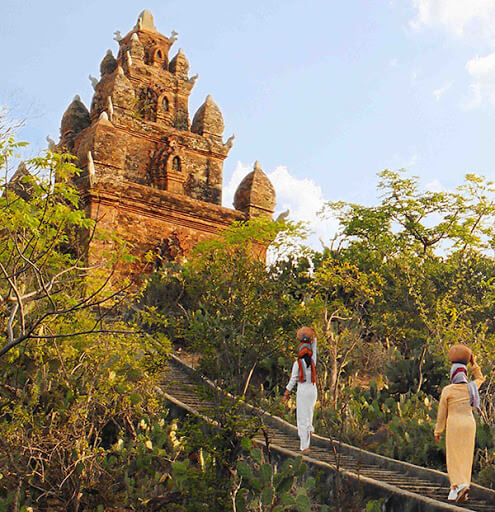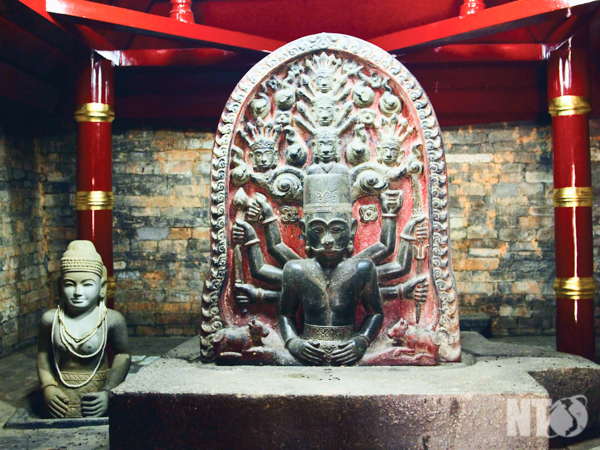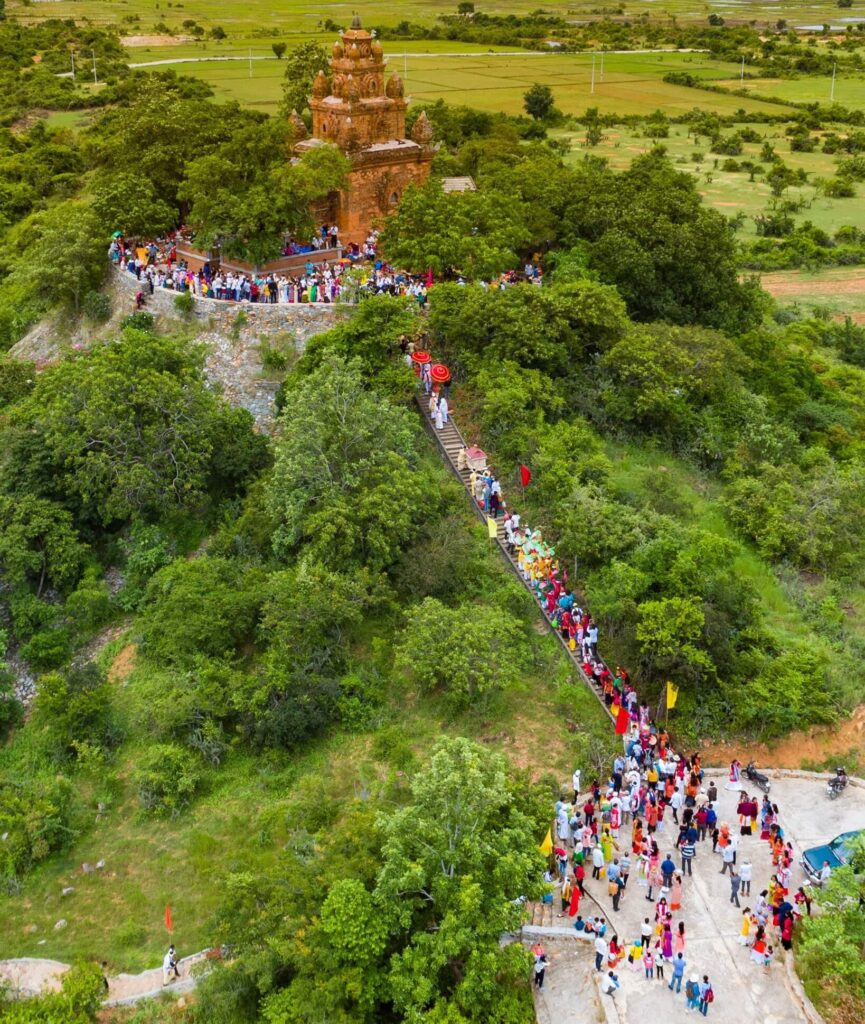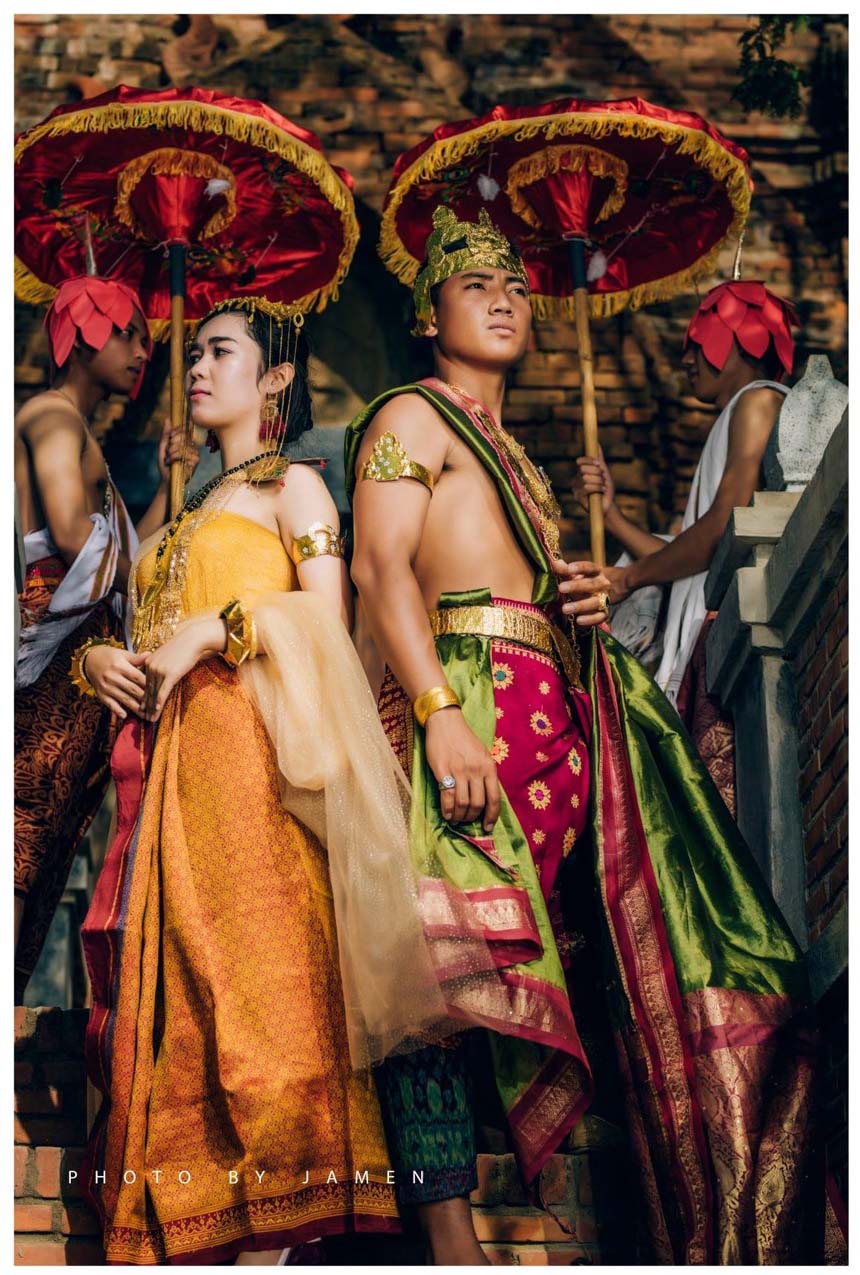Po Rome Tower located on a hill between two mountains in Hau Sanh village, Phuoc Huu commune, Ninh Phuoc district. It is 15 kms to the south from Phan Rang city; about 7km from the center of Ninh Phuoc district and about 6 km from 1A National Highway to the west, or about 4.5 km from the People’s Committee of Phuoc Huu commune.

When it comes to Ninh Thuan, everyone knows that this is a windy land, the capital of grapes and the place where the largest herds of goats and sheep are raised in Vietnam. However, as a child of Phan Rang, I am always impressed and feel proud because this place is not only blessed with natural resources and beautiful scenery, but also has many architectural works and imbued with Cham culture.
In Ninh Thuan, many tourists will know about Po Klong Garai tower or Hoa Lai tower, but very few people know about this ancient work – Po Rome tower. If you are curious about this tower, let’s follow me to explore this ancient tower.
Why it is called Po Rome?
Back in the days, the Po Rome tower was built in the late 16th and early 17th centuries during the reign of King Po Rome (1627 – 1653). Po Rome tower was built in the same architectural style as PoKlong Garai tower, but it is not worshiping god but King Po Rome. Because he was a very talented person and had great merits for the people, the king was respected by the Champa people and considered to have turned into a god when he died.

Po Rome Tower is an ancient work of the Champa people in the Panduranga region. Although not elaborately built like Hoa Lai and PoKlong Garai towers, it was built with meticulous and majestic red bricks from the ancient Champa. In particular, Po Rome tower is the most intact tower of great value in terms of architectural art despite having gone through many wars.
What is the architecture of Po Rome tower like?
The project consists of 2 towers, the main tower and the auxiliary tower. In particular, the main tower is for worshiping King Po Rome and Queen Po Bia Sancan. The other tower is a sub-tower to worship Queen Pra Sucih, especially the burial area of King Po Rome is close to the sub-tower.
The main tower is about 8ms high, with 8ms wide at the bottom edge, the main side of the tower faces to the East, on the main door there are arc-shaped layers, under the arcs are decorated with the image of the god Siva and a flame shape.
At the other doors, there are some sitting stone gods. When observing the roof, is a three-storey roof architecture, each floor has 4 corner towers, at the top of each corner tower is decorated with stone lotus buds and flame shapes. Especially in each niche is an image of a god sitting with his hands in a prayer position.
A statue of the bull god Nadin was carved from a dark blue stone, and placed at the corner of the tower’s entrance, which is similar to the main tower of Po KLong Garai. The shape and size of the Po Rome tower is narrow and extends to the East-West.

Inside is a simple layout of a 1.2m King Po Rome statue, which is carved from an 8-armed Linga, placed on a wooden pedestal. Near the statue of King Po Rome is a statue of queen Po Bia Sancan about 0.75m high. In order to get to the tower, visitors have to go through dozens of stairs built with large stone blocks.
Po Rome Tower was recognized as a National Historic Site in 1992. It is a place where Champa people regularly organize festivals and traditional New Year’s Day of the nation.
Several festivals are held at Po Rome tower
- (Yuer yang) takes place in the April of the Champa calendar.
- Kate ceremony (Mbeng Kate) takes place in July of the Champa calendar.
- The ceremony to the Mother of the Land (Cambur) is held in September of the Champa calendar.
- The opening ceremony of the tower (Peh Mbeng Yang) takes place in November (Bilan Puis) of the Champa calendar.

Let’s take a look back to find out why King Po Rome was loved by the people, so much that they built a temple to worship him
According to the page “Holy Land of Vietnam”, King Po Romé is a historical king, often appears in the Chronicles of Champa. After his death, he was honored by the people and became a god that Champa people always worship every year.
According to many legends, King Po Rome came from a family whose father and mother were both originally from Chu Ru. However, he is famous throughout the region as a person of great intelligence, outstanding talent, especially his appearance that clearly shows the fate of a god in the future.
Later on, his outstanding talent has caught the eye of Princess Po Bia Thon Chon (daughter of Champa King, Islam Po Muh Taha). Two of them fell in love and he became the king’s son-in-law and was handed the throne by King Po Muh Taha.

King Po Rome’s life and career was a story both tragic and heroic. Most of the tragedy is related to the marriage with princess Ngoc Khoa – the third wife named Bia Ut.
Many legends said that King Po Romé married Princess of Dai Viet because he was infatuated by her beauty, but in reality it was just a diplomatic move. Because during his rule, King Po Romé not only married the princess of Dai Viet but also married an Ede woman to tighten solidarity with the highland ethnic groups. In addition, he also married a princess of a small Malay state in order to form an alliance with the Polynesian countries.
Some documents in 1653 told that, the Lord of Nguyen, Nguyen Phuc Tan ordered the captain Hung Loc to bring 3,000 troops to capture the remaining land of Champa from Nha Trang to Phan Rang River. King Po Rome was arrested and locked in a cage, starved and thirsty on the way back to Hue. On the way, Po Rome committed suicide.
Some achievements of King Po Rome:
He had the merit of leading the water to enter the land for the homeland and the country, so after his death, the people worshiped him as a god in the Champa religion. To these days, the irrigation works are still used for irrigation activities by residents in the area, showing the essential role and merit of the person who directed the opening of these works in the past.
Development of Champa language: before Po Romé, the Champa people used Sanskrit and ancient Champa to write on inscriptions in temples and towers, but since Po Rome’s period, a new Champa language has been formed. Since then, this script has not stopped improving, and is widely used until now, the Champa people still use it as a common language.
Tightening links between ethnic groups and uniting them: this is proven by the fact that King Po Romé married a native of Radhe (Ede), and also through the legend of Po Nai (Nai Tang Riya Bia Tapah), according to one version of this legend, Po Nai was the daughter of Po Romé, who was married to a Raglai man, who was most likely a Raglai leader.
Po Rome was probably the last king of Champa, maintaining its independence and autonomy from Dai Viet. He is the person always worried about the fate of the country. He had built a strong agricultur and helped people live in peace for more than 20 years. Po Rome tower is one of the works in which people express their gratitude to him.
Besides, you can choose your programs to experience the sun and wind in Phan Rang that are suitable for you so as not to affect the experience and conditions of each group – family. For specific advice, customers can message directly via Fanpage: Hello Phan Rang – Khám phá Ninh Thuận qua góc nhìn bản địa
See More: Phan Rang City tour – Explore Ninh Thuan through the local eyes
See More: Why is Banh xeo Phan Rang different from others?


